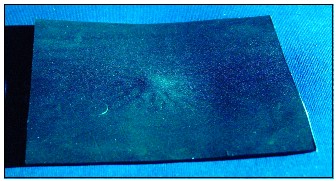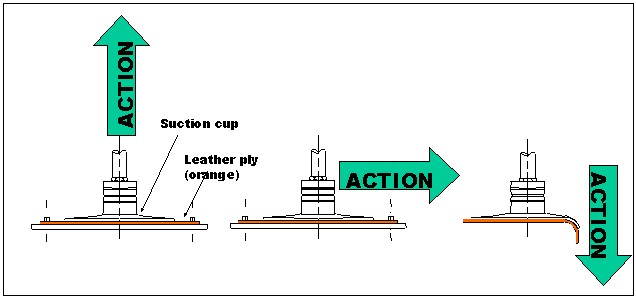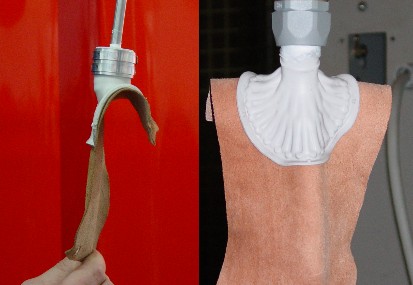|

| |
The first step in designing the new system for leather manipulation has been
the selection of a suitable suction element able to:
- perform a stable grasping in different working conditions;
- avoid visible imprinting on the leather surface.
Different commercial vacuum cups, recommended by producers, have been tested,
but their performance were largely insufficient. The only one, able to grasp
correctly the leather plies, produced visible imprints on the leather surface.

At the end of this first test session, the hypothesis of an insufficient
softness and flexibility of all the tested commercial suction cups was put
forward. Many innovative models of vacuum cups have been therefore designed,
varying the cup shape and its internal arrangement. The main features of these
vacuum cups are:
: an adequate material with an very high ultimate
elongation was used for all the tested models. It is a very flexible
material, also able to stand chemical attacks. The high flexibility allows the
cup to perfectly match the waviness of the leather plies;
cup shape: a planar shape has been used for all the tested models. In
this way the flexibility is increased and the imprinting effect on the leather
surface is minimized;
working surface: the contact between cup and leather is critical for the
success of the grasping. An appropriate grooved surface contributes to
reduce the imprinting effect;
cup profile: an adequate profile can reduce the imprinting effect;
border shape: the border of the vacuum cup is the sealing element,
necessary to maintain the vacuum between the cup and the leather. A sharp border
could be very effective from the grasp point of view, but it increases the risk
of imprints.

Many kinds of leather plies with different thickness have been used to
perform the tests, and the developed vacuum cups have been tested considering
the following parameters:
exerted when the cup is pulled along a direction
perpendicular to the leather surface and coaxial with cup itself;
maximum lateral force exerted when the cup is pulled along a direction
parallel to the leather surface;
stripping force needed to separate the leather ply from the cup by a
strip action applied on the edge of the grasped element. This aspect
is very important since it measures the capability of the cup to retain the ply
when a portion of it is pending laterally;
surface imprinting: it represents the damage produced by the cup on the
leather surface and depends on the internal arrangement of the suction cups, as
well as on the vacuum degree. The damage level has been estimated by means of a
visual comparison performed by a human expert.

As far as the surface imprinting is concerned, all the developed cups gives
very good performances. In particular the vacuum cup showed in the previous and
the following pictures does not produce
any imprinting effect also at the highest vacuum degree, and is able to keep the
grasp also under high load conditions.
This device is patented.

|
